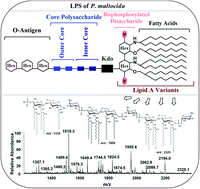Mass spectrometric analysis of lipid A obtained from the lipopolysaccharide of Pasteurella multocida
Abstract
Haemorrhagic septicaemia is mainly caused by an opportunistic pathogen, Pasteurella multocida, a major threat to the livestock dependent economies. The main endotoxins are lipopolysaccharides. The lipid A, a key pathogenic part of lipopolysaccharides, anchors it into the bacterial cell membrane. Hence, profiling of the lipid A is important to understand toxicity of this pathogen. Despite a significant progress made on glycan analyses of core regions of lipopolysaccharides from various P. multocida strains, the structure of lipid A has not been reported yet. The lipid A of P. multocida type B:2 was analyzed using ESI-MS/MS to identify the acylation patterns, number and length of various acyl fatty acids, phosphorylation level and lipid A modifications. The MSn data revealed the existence of multiple lipid A variants, i.e. mono and bisphosphorylated hepta-, hexa-, penta- and tetra-acylated structures, decorated with varied levels of 4-amino-4-deoxy-L-arabinose (Ara4N) on C-1 and/or C-4′ phosphate groups of proximal and distal glucosamine lipid A backbone. The detailed mass spectrometric analyses revealed that even within the same class, lipid A exhibits several sub-variant structures. A primary and secondary myristoylation at C-2, C-3, C-2′ and C-3′ was observed in all variants except hepta-acylated lipid A that carried a secondary palmitate at C-2 position. The lipid A profiling described herein, may contribute in exploring the mechanisms involved in endotoxicity of P. multocida type B:2 in haemorrhagic septicaemia disease.



 Please wait while we load your content...
Please wait while we load your content...